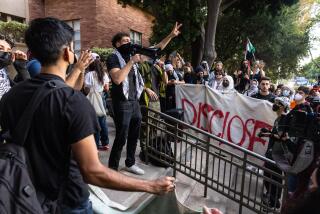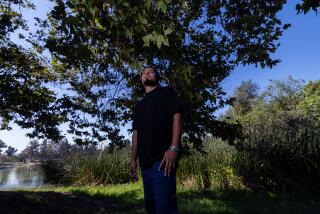REGIONAL REPORT : Diversity Marks New Anti-War Movement : Protest: Southland coalition lags national effort, but is growing by enlisting veteran activists and neophytes.
- Share via
Al Jacobs, a Los Angeles engineer whose son is serving in the Persian Gulf, voted for President Bush. But now he plans to march against him.
Shirley Cereseto of Orange County has been an anti-war protester since the death of her husband in World War II.
Mark Thayler, a 19-year-old Riverside college student, opposes the buildup in the Mideast, fearing he will be drafted.
Their reasons for opposing U.S. involvement in the Persian Gulf are as varied as their backgrounds.
Nonetheless, they are part of a small but growing and highly eclectic peace movement across the Southland that has become more vocal as a Jan. 15 deadline for Iraq’s withdrawal from Kuwait nears. Even Saddam Hussein’s decision to free foreign hostages has fueled--rather than defused--their furor.
“We won’t be deterred until we see President Bush taking the troops out,” said Carol Jahnkow, director of the Peace Resource Center in San Diego. “If anything, people are seeing progress, and we want to keep up our efforts.”
To be sure, protests in the Southland have yet to draw the numbers that marches and rallies have drawn across the country.
On Oct. 20, a day selected by a network of peace organizations for nationwide protests, 4,000 people marched down Broadway to Times Square in New York; 1,500 raised their voices in San Francisco. But in Los Angeles, there were only 400.
The reason for the smaller crowds here may lie in the nature of the region itself. It is more difficult to spawn a movement in Southern California cities than in other major cities, organizers say. “It is simply harder to get people out of their houses in L. A.” said Leila Rand, a spokeswoman with the Los Angeles Coalition Against U.S. Intervention in the Middle East. “When you have a demonstration in L. A., how far are you expecting people to drive?”
But while scattered protests drew only a handful of demonstrators months ago, rallies now draw scores, even hundreds. Throughout the region, an event is planned virtually every week, often by groups newly formed in response to U.S. involvement in the Mideast.
Today, a teach-in organized by the Los Angeles Coalition Against U.S. Intervention in the Middle East is scheduled at Fairfax High School in Los Angeles. In several cities and towns, including Los Angeles, San Diego, Laguna Beach and Seal Beach, small rallies are held every weekend. Some, like a recent one at Mile Square Park in Fountain Valley, drew 400 people.
“Is anti-war sentiment growing?” asked one father, whose son was deployed to the Middle East. “No, it is exploding.”
“Even in Orange County, we have a peace movement--and we are usually not out in front in those things,” said Cereseto, 68, a peace activist for about 50 years and a founder of the month-old Orange County Coalition for Peace in the Middle East. This group, like others in the Southland, is circulating petitions to be presented to Bush in January, as well as organizing teach-ins at colleges and high schools.
Among the activists are offspring of Vietnam-era protesters and longtime members of peace organizations who have remained involved over the years in anti-nuclear weapons and environmental movements.
Others, such as Jeanne and Bruce Ertle, are new to anti-war protests.
The Ertles, of San Diego, recently joined the weekly Sunday peace vigil in Balboa Park. Their two sons, Stephan, 19, and Jeffrey, 24, have joined them in opposing the use of U.S. military force, which, they say, would divert funds from more necessary programs for the poor. And such a venture, they say, would only create more unrest in the already-tense Middle East.
“If we do this, it’s going to create an endless chain of problems later because we are going to alienate the Arab world,” said Bruce Ertle, 50, a graphic artist who had traditionally voted Republican and grew up in a military family.
Also among the ranks are people like Al and Norma Jacobs, who have sons or daughters, husbands or wives who have been sent to the Persian Gulf.
“I am not a peacenik or a flower child; I am just a guy who has a son out in the Persian Gulf and who sees all these young fellas out there,” Al Jacobs said. “Bush is not God. And what he’s doing now really doesn’t make sense.”
For the Jacobses, the gulf crisis has forced them to accept political allies among people they might ordinarily avoid. Unlike some of the more ardent anti-war activists, they shun such radical acts as flag burning. In fact, alarmed by what they regarded as unpatriotic rhetoric, the couple walked out of their first political meeting two weeks ago in Los Angeles.
But the Jacobses quickly realized they could ill afford to ignore what they now regard as the other half of the peace movement, the more traditional activists. Today, they have united in their efforts to organize a nationwide demonstration in early January.
Although the movement’s leaders are buoyed by the diversity the anti-war effort has attracted, it presents a dilemma as well.
To accommodate political neophytes and longtime protesters, organizers say, they must focus their message carefully: They oppose the war and support the troops. The theme represents a major departure from the Vietnam War protests, when the soldiers themselves were often the target of anti-war sentiment.
During a recent meeting at a San Diego law school, for example, more than 100 activists hotly debated whether to stage protests at the docks when Navy ships left for the gulf.
“You would be dividing my loyalties since my wife will be on one of those ships,” said Mike Meyer, a 26-year-old San Diego student who left the Navy after four years of service.
With an almost unanimous vote, the group decided that a dockside protest would be more damaging than helpful by alienating military families. Instead, they opted for a press conference at a separate location and a different time, vowing to come up with good visuals for television cameras.
Tools of the movement include petitions, letters to politicians and demonstrations.
Activists plan fund raising, hone strategies for obtaining big-name stars, and calculate how to woo the media. So far, those efforts have met with limited success. Actor Ed Asner and singer Holly Near have signed on to participate in today’s Los Angeles teach-in.
The memory of Vietnam has enabled organizers to pull together groups in a relatively short time. In the Vietnam War era, many religious leaders waited a decade before they voiced their opposition. But shortly after Iraq invaded Kuwait, some--from Catholics to Lutherans to Episcopalians--began opposing the possible use of U.S. military force.
“There is much more awareness now than there ever was at this stage in Vietnam because people have learned from the past,” said Edna Bonacich, professor of sociology and ethnic studies at UC Riverside. “In Vietnam, we had the enemy ‘communist’ who gave the war a lot of legitimacy. Now people are asking: ‘What are we doing there? Are we fighting for oil, and it isn’t even our oil? Would we invade if this was not oil territory, if Kuwait was producing potatoes?’ ”
But, they acknowledge, there are important differences between the anti-war climate now and in the 1960s. Because body bags have not come home, this conflict is not yet one of life and death. Because there is no draft, anti-war sentiment has not ignited college students.
To Bonacich’s frustration, public opinion polls have a mixed message. According to a new Times Poll, 61% approve of Bush’s actions, an increase from 54% in November--but still lower than September’s 78%. Asked what the U.S. should do once the hostages are free, 37% backed invading Iraq if it refuses to pull out of Kuwait. However, in a Newsweek poll a week ago, a majority of Americans--56%--supported military action.
Disturbed by what she viewed as students’ passivity, Bonacich helped form a small group of politically concerned students and teachers. This month, for the first time, the group orchestrated a rally of about 100 people on the small, conservative campus. Alarmed about the possibility of the draft’s being reinstated, sophomore Mark Thayler joined the protest.
“When you are 19, listening to the news and hearing the President try to sell the idea of war,” Thayler said, “you realize, ‘I am one of those lives he is talking about sending over there.’ ”
For Pat Laru and many others, protest is the only action they can take to make them feel less powerless.
Laru, a 54-year-old clerical supervisor with San Diego’s probation department, can scarcely believe she is once again protesting for peace. Laru, who describes herself as an ardent feminist and a single mother, burned effigies of the governor during the anti-war movement in Cambridge, Mass., in the ‘60s.
When her son, Jeff, joined the Marine Corps two years ago, she figured it was the ultimate rebellion of a young man who grew up in a liberal home. She demanded he see violent Vietnam movies--”Platoon,” “Full Metal Jacket,” “Apocalypse Now”--but had no luck in dissuading him.
Jeff, now 21, called two weeks ago and haltingly told her his unit was being shipped out to the Persian Gulf area. His words electrified her with fear. She said they discussed various ways he could avoid being deployed: start a barroom brawl, lie to his supervisor and say he was gay, or apply for conscientious-objector status.
Laru advised her boy, “Save your skin,” and when the call ended, she wept. Now she regrets that she had not forcefully prohibited her son from joining the Marines. She also regrets that she had not earned more money so she could have offered her son more options after he graduated from high school.
Lately, Laru has not slept well. She does not know when Jeff will call again or what he decided to do. She has terrible dreams. She wakes up crying, soaked in sweat, having dreamed that Jeff is lying dead on an airstrip in Saudi Arabia.
“When I held him as an infant, I thought this was one baby who was not going to be machine-gun fodder,” Laru said. “This is terror. This is a mother’s nightmare.”
More to Read
Sign up for Essential California
The most important California stories and recommendations in your inbox every morning.
You may occasionally receive promotional content from the Los Angeles Times.










